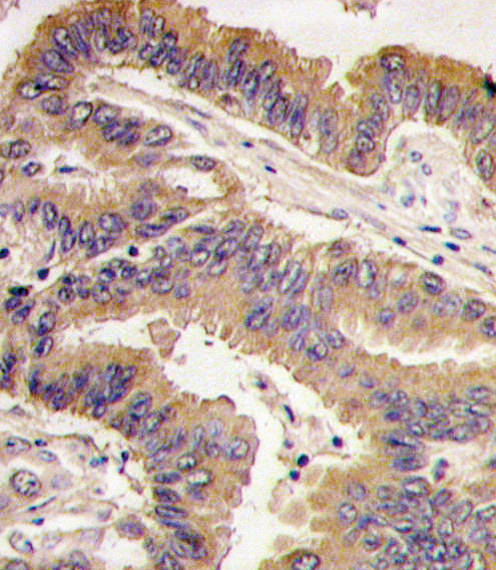

| WB | 咨询技术 | Human,Mouse,Rat |
| IF | ImmunoprecImmunoprecipitationitation/ 2-5 ug/mg lysate | Human,Mouse,Rat |
| IHC | 1/100-1/300 | Human,Mouse,Rat |
| ICC | 1/200-1/1000 | Human,Mouse,Rat |
| FCM | 咨询技术 | Human,Mouse,Rat |
| Elisa | 1/40000 | Human,Mouse,Rat |
| Aliases | Growth/differentiation factor 5, GDF-5, Bone morphogenetic protein 14, BMP-14, Cartilage-derived morphogenetic protein 1, CDMP-1, Lipopolysaccharide-associated protein 4, LAP-4, LPS-associated protein 4, Radotermin, GDF5, BMP14, CDMP1 |
| Entrez GeneID | 8200 |
| WB Predicted band size | 55.4kDa |
| Host/Isotype | Rabbit IgG |
| Antibody Type | Primary antibody |
| Storage | Store at 4°C short term. Aliquot and store at -20°C long term. Avoid freeze/thaw cycles. |
| Species Reactivity | Human |
| Immunogen | This GDF5 antibody is generated from rabbits immunized with a KLH conjugated synthetic peptide between 13-41 amino acids from the N-terminal region of human GDF5. |
| Formulation | Purified antibody in PBS with 0.05% sodium azide,1%BSA and 50% glycerol.prepared by Saturated Ammonium Sulfate (SAS) . |
+ +
以下是关于Adducin α/β抗体的3篇参考文献及其摘要内容概括:
---
1. **文献名称**: "Adducin: Structure, Function, and Its Role in Hypertension"
**作者**: Bianchi G, Tripodi G
**摘要**: 该研究探讨了Adducin α(ADD1)和β(ADD2)亚型的基因多态性与盐敏感性高血压的关系,发现特定ADD1突变会增强肾小管钠离子转运。研究中利用Adducin α/β抗体进行蛋白质表达分析,证实突变体Adducin对细胞膜离子通道的调控异常。
---
2. **文献名称**: "Adducin Binds to the Spectrin-Actin Complex and Promotes Oligomerization"
**作者**: Matsushima N, Izumi Y, Moriyama T
**摘要**: 本文通过免疫沉淀和Western blot技术,使用Adducin α/β特异性抗体,揭示了Adducin与spectrin-actin复合物的相互作用,证明其通过促进spectrin寡聚化维持红细胞膜稳定性,为细胞骨架动力学研究提供关键证据。
---
3. **文献名称**: "Role of Adducin in Podocyte Injury and Proteinuria in Diabetic Nephropathy"
**作者**: Fuchs TC, Hewitt P, Ryan A
**摘要**: 该研究利用Adducin α/β抗体在糖尿病肾病模型中检测足细胞损伤,发现Adducin表达下调与细胞骨架破坏相关,提示其作为肾病生物标志物的潜力,并通过免疫荧光证实其在肾小球中的定位变化。
---
这些文献均涉及Adducin α/β抗体的实验应用(如Western blot、免疫荧光),并围绕其结构功能、疾病机制展开研究。
Adducin α/β antibodies are essential tools for studying the adducin protein family, which comprises α, β, and γ subunits. These proteins form heterodimers or heterotetramers and play a critical role in stabilizing the spectrin-actin cytoskeletal network, maintaining cell membrane integrity and mechanical properties. Adducins are particularly abundant in erythrocytes, neurons, and renal tissues, where they regulate cell shape, adhesion, and motility. Additionally, they participate in signal transduction, ion transport, and synaptic plasticity by interacting with proteins like protein kinase C (PKC) and calmodulin.
Research using Adducin α/β antibodies often focuses on their post-translational modifications (e.g., phosphorylation) and subcellular localization. These antibodies are widely applied in techniques like Western blotting, immunofluorescence, and immunoprecipitation to investigate adducin expression patterns in health and disease. Dysregulation of adducins has been linked to hypertension, neurodegenerative disorders (e.g., Alzheimer’s disease), and cancer progression. Notably, polymorphisms in the ADD1 gene (encoding α-adducin) are associated with salt-sensitive hypertension, influencing renal sodium handling. In cancer, altered adducin expression may promote metastasis by modulating cytoskeletal dynamics. Thus, these antibodies not only aid in basic research but also hold potential for developing diagnostic or therapeutic strategies targeting cytoskeleton-related pathologies.
×